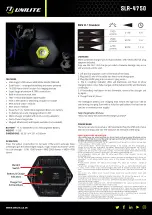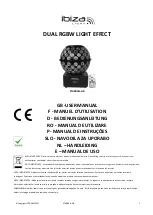
PAGE 4 OF 4
EMERGENCY DRIVER
INSTRUCTIONS
Operation / Testing / Maintenance
Operation
When AC power is applied, the LED test switch will be illuminated, indicating that the batteries are being charged.
When AC power fails, the ESL-EMG-2DC automatically switches to emergency power, operating the LED loads
at the rated power. The LED test switch will switch off. When the AC power is restored the emergency module
switches the system back to normal operation and resumes charging the battery. The minimum emergency
operation time is 90 minutes. The charging time for the full discharged battery is 24 hours.
Testing and Maintenance
Manual Test
LED Test Switch Indications
Performing periodical tests are recommended to ensure the system is working properly.
Auto Test
The ESL-EMG-2DC Series has an auto test function which saves the cost of manual maintenance.
(1) Press the LED test switch one time to put into emergency mode. (2) Press the LED test switch two times within
5 seconds to put into monthly test sequence. After test is finished the next monthly test will count from this date.
(3) Press the LED test switch three times within 5 seconds to put into annual test. After test is finished the next
annual test will count from this date. (4) During the manual test, press the LED test switch above 3 seconds, then
the manual test can be terminated (the preprogrammed scheduled auto test time will not change).
1.
Visually inspect the LED test switch monthly. IT should be illuminated when AC power is present.
1.
Instant Auto Test:
When the system is connected properly and powered on the ESL-EMG-2DC model will auto
test if the load and battery pack is connected properly and the battery is charging as normal. If there is any
abnormalities, the LED test will flicker. The the abnormality is resolved, the test switch will stay lit with no flicker.
2.
Conduct a 30 second discharge test by switching off the main power every month. The LED test switch should
switch off and LED loads should operate at reduced illumination.
2.
Preprogrammed scheduled Auto Test:
(A) Carry out first monthly auto test after initial power on for at least a full
24 hours or more. Afterwards carryout a monthly auto test every 30 days. (B) Carry out a annual auto test every
52 weeks after first power on. (C) Auto test timing. To reduce the conflict that auto test is executing when the
lighting is in use, the preprogrammed scheduled auto test will be executed 2 hours later than the normal
operation is disconnected (switched off). For applications where lighting remains illuminated, the module will
postpone the scheduled test accordingly, but will not postpone later than the preprogrammed scheduled
latest test time. (D) Monthly auto test. The Monthly auto test should be executed every 30 days and should test
for; the switchover of normal and emergency modes; if the emergency functions and that the battery charging
and discharge condition is normal. Auto test time is approximately 30 seconds. (E) Annual auto test. The annual
auto test should be executed every 52 weeks after a full 24 hour charge of the battery. This will test; if the
battery voltage is equal to or higher than the limit after a full 24 hour charge; if the emergency operation time is
over 90 minutes; if the battery voltage after 90 minutes of emergency operation is equal to or higher than 87.5%
of the initial voltage.
- During the auto test, in case a power failure happens and the power cannot be on until the auto test completes,
the auto test will be performed again after AC power has been on for 24 hours.
- If the emergency mode makes the battery discharge completely under the power off condition, the
preprogrammed scheduled auto test will resume as soon as AC power is restored.
3.
Conduct a 90 minute discharge test once a year. The LED loads should operate at reduced illumination for
at least 90 minutes.
- LED test switch on: Normal
- LED test switch off: Power failure
- LED test switch gradual change: In testing mode - LED test switch flickering: Abnormal issue
Copyright © 2018 ESL Vision, LLC. All rights reserved. Rev: 08/15/2018






















